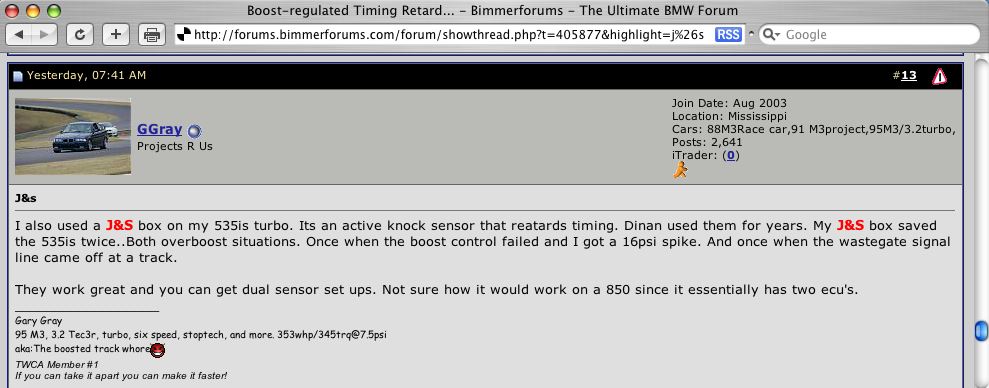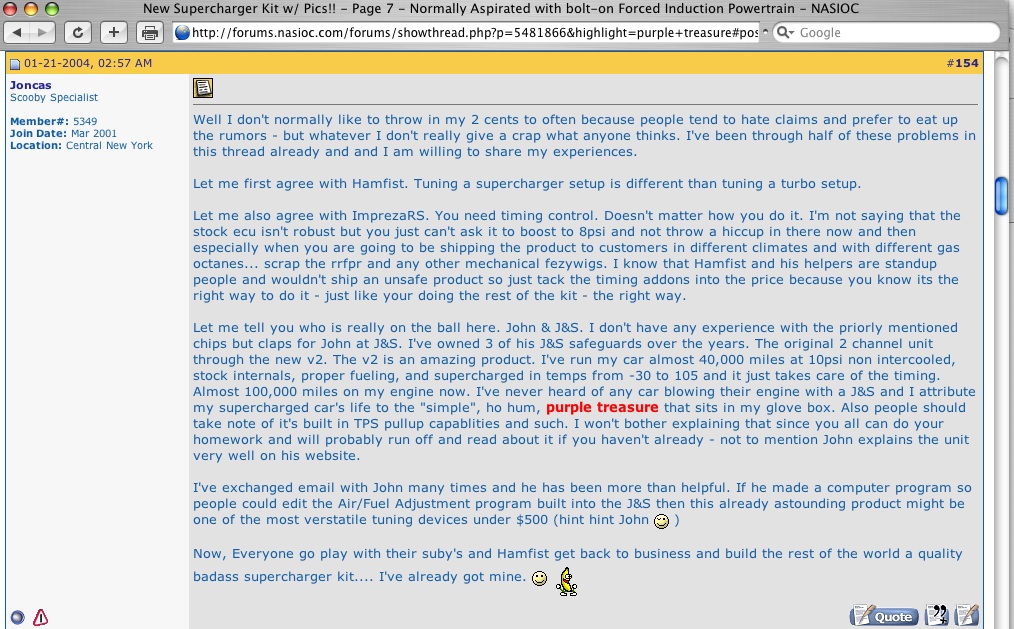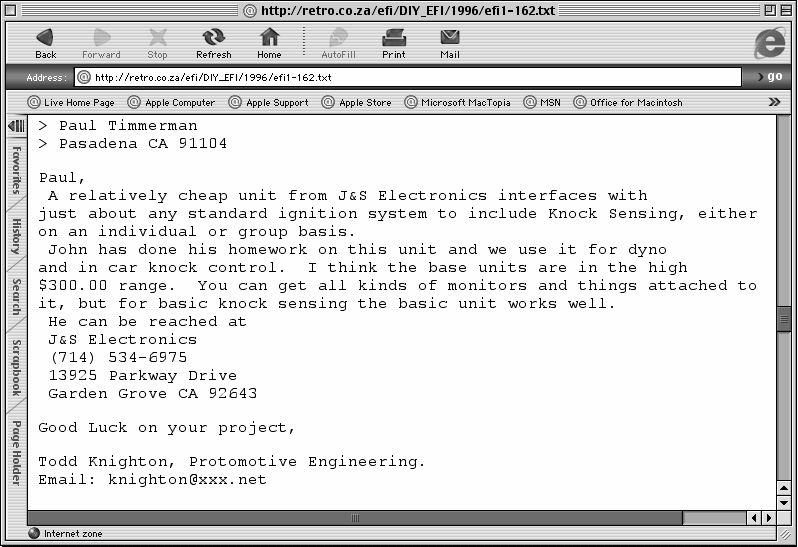

A few comments from users on different forums. Links are provided to read the entire thread if desired.
ttp://www.alltrac.net/phpBB2/viewtopic.php?p=8905&highlight=safeguard#8905


http://forums.nasioc.com/forums/showthread.php?p=5481866&highlight=purple+treasure#post5481866



http://forums.nasioc.com/forums/showthread.php?t=831718&highlight=j%26s

To: "John Pizzuto (E-mail)" <jpizzuto@jandssafeguard.com>
Date: Sunday, September 1, 2002 11:26 PM
Subject: SafeGuard Praise
Hi John & Shirley,
This is from the Corvair list:
Best Regards,
Ray
----------------------------------------------
Subject: <VV> Northwest passage
Hi all,
(snip)
It was interesting to see the Safeguard pull the timing
back at just about the time you would expect - full throttle up a
grade in third @ 2500 for example. Not so much that you could
really feel a power difference, but totally stopped any knocking.
The plan was to get this done by the weekend of Aug 10, and we
took a
couple ferries to lovely Victoria, BC (that's in Canada, eh?) for
Corvairitus treatment day.
<snip>
Ford Focus user:
I'm very satisfied with the unit. It definitely gets rid of knock.
When I got the sensitivity adjusted, it was pulling 4 degrees of timing in the area I suspected ping.
I thought that this might be a little much so I re-routed my fuel pressor sensor vacuum hose from the top of my JRSC blower to the rear fitting as suggested by OJ. (I did this before but since I still had knock, I put it back to the original location.)
Now, I only get 1 to 3 degrees of timing pulled and it's not static. I see it flicker between 1, 2 and 3. This was in the pull all cylinder mode.
I set it to individual cylinder mode and I only see 1, 2 or sometimes 3 flicker very quickly. Never lit constant or a duration longer than 1 second at most.
This only occurs when I WOT in 3rd gear. I haven't seen the monitor light up when I WOT in 1st, 2nd, 4th or 5th. This justifed my suspicions about 3rd gear and WOT regarding knock.
I can not tell a difference in power and NO knock !!!!!
I can not be more pleased with this product and I will say this was money well spent.
When I gather up some more cash, then it's tuning time to fine tune the knock out of the ECU program.
Great job on your invention John and I'm pleased to say I'm glad I stumbled on your product here at FJ.
Ian Whiiteside's review, after testing on his F3 engine:
To: jands <jpizzuto@jandssafeguard.com>
Date: Monday, October 31, 2005 3:52 AM
Subject: RE: Dyno results with Safeguard
I sold the car a few weeks ago, I however had no problems with the
controller. When I was on the dyno, the operator seemed quite impressed but
I wouldn't tell him what make the system was - the dyno was also used by an
engine builder who builds most of the engines in my race series, so didn't
want to give away my secret weapon!
I'll check out the Forum. I have posted on these type of things before but
find it very frustrating when people start quoting folk-lore at you and
disagreeing with the basic laws of physics - I normally just let them
carry-on in ignorance. I have attached the actual dyno results for you to
look at, now I have sold the car then you can post them on the forum if you
like. The dyno control was a little poor which is why the torque curves look
so 'bumpy'. First test was with 98 RON fuel without the controller and the
EMS calibrated to 2? clear of knock, next test is again with 98 RON fuel but
with 4 deg spk adv added to the previous map. Next two curves are using the
102 RON 'control' fuel for my race series, this was tested at +4 and +6
degrees from the base map ( i.e. 2 and 4? beyond detonation ).
Here is a reply to post on the forum:
"Firstly I will explain my background, I am a performance development
engineer for a company called Ilmor Engineering in the UK. For those of you
how haven't heard of it, it designs and manufactures race engines for
'premier' race series and has been involved with such championships as F1,
IRL, CART, NASCAR etc. My use of the J&S knock controller was purely for
personal use and in no way is this an endorsement of the product my Ilmor
Engineering. I have mentioned my background purely so you know that I speak
on the subject with some authority.
When the spark is initiated, the fuel/air mixture in the chamber starts to
burn and the flame front travels from the spark plug to the edge of the
cylinder. This advancing flame front heats and compresses the unburnt
fuel/air mixture at the edge of the cylinder and under certain circumstances
the pressures and temperature become so high that the whole mixture
spontaneously combusts. This effect is called Knock ( or Detonation ) and
gives a very sharp rise in cylinder pressures and normally an audible
'knocking' noise from the engine. The knock causes erosion of the cylinder
head and piston if run for sustained periods of time, which is clearly
undesirable. Under extreme conditions, the knocking can also raise the
temperature of certain regions of the combustion chamber to values that
cause the mixture to ignite before the spark plug is fired, this condition
is known as Pre-Ignition and usually results in an instant melting of
pistons or head gasket failure. Both Knock and Pre-Ignition are very harmful
to the engine and should be avoided at all costs.
For any speed and load point on an engine there will be an optimum spark
advance that gives maximum torque ( this is referred to as MBT - 'Minimum
spk adv for Best Torque' ), if we advance or retard the ignition from MBT
then the engine performance will decrease. Clearly what we want to do is run
the engine at MBT all the time in order to get best performance, however
this is not always possible because of knock. From my brief description of
the knock process, it can be seen that it is the result of 'time exposed to
high temperatures', i.e. an engine will knock more at high load, low speed,
high compression ratios and low grade fuels. It is also strongly effected by
such things as high coolant temperature, high air temperature as well as
secondary factors such as oil temperature and humidity. In an ideal world it
would be possible to map your engine at all the possible conditions in which
it may run, but this will take you many weeks on the dyno due to the large
number of factors! What is normally done is to map the engine at a few
different temperatures and then retard the ignition by 2 or 3? to provide a
'safety factor' for all the other unknown conditions that haven't been
tested. This extra 'safety' spark retard reduces the performance of the
engine, what is needed is an 'active' system that detects knock and only
retard the ignition when it is present - i.e. a Knock Controller.
I hear that people are saying 'you should tune for no knock'. Sounds good in
principle but how do you do it? The only way is to reduce the temperatures
and pressures in the cylinder, i.e. close the throttle or reduce boost -
clearly not a way to maximum performance!
I understand that John has posted some performance figures from my engine, I
have now sent him the full dyno data so hopefully he can post that for you
to look at as well. My engine is a 2 litre naturally aspirated 4 cylinder F3
engine, it is fitted with a 24mm inlet air restrictor as specified by the
series rules. This restrictor has a severe effect on the engine performance
and starts to choke the engine from about 5000rpm upwards. In order to get
maximum power from the engine it needs to be very 'efficient' in its use of
this limited air supply, the main way to do this is to raise the compression
ratio - it runs at 14:1. At the higher engine speeds, the engine is not that
knock limited as the lack of airflow reduces cylinder pressures. However at
the lower speeds where it is no being restricted it is highly knock limited
due to the very high compression ratio. For instance at around 4000 rpm, the
engine runs only 12? spark advance which is approximately 10-15? retarded
from MBT. Under these conditions the gradient of engine torque against spark
advance is very steep so a 2? 'safety margin' causes a significant loss in
performance.
By using a knock controller it is possible to eliminate this 'safety margin'
and gain performance. The other advantage of the controller is that it can
retard only the actual cylinder that knocked rather than the whole engine.
Due to subtle difference between cylinders it is very likely that one
cylinder will knock before the others. With the controller in 'individual
cylinder' mode, the knocking cylinder can run a little retarded to prevent
knock whilst the others can run closer to MBT and thus give you an extra
performance advantage.
I guess this forum is about cars with after-market turbo conversions and
these are the ideal sort of vehicle that would benefit from a knock
controller. A turbo engine produces lots of power as well as low speed
torque, it also has high air inlet temperatures - these combine to make
turbo engines very knock limited particularly at low speed ( very much like
my F3 engine ). By fitting a knock controller you will not only gain
significant increases in performance but will have the peace of mind that
the engine will be safe under any extreme ambient conditions you may
experience or say if you fill up with the wrong fuel grade.
If knock control is so good then why don't production cars use it you may
ask? The answers is that many of them do, most 'high-end' and performance
cars build in the last 5 years or so probably have knock control. Bosch is a
very strong advocate and a modern car with Bosch engine management will
have knock control. The J&S unit may be an after-market item but is works on
the same principle as the OEM controllers. Go and buy one, it is easy to
install and set-up and is a very cost effective way to more performance.
I re-confirm that I have no connection with J&S - I have only purchased one
of their units and am very pleased with the way it works. I have written
this article to help people understand how it works and what benefits they
will receive - hopefully I haven't baffled you with too much science!
Ian Whiteside"